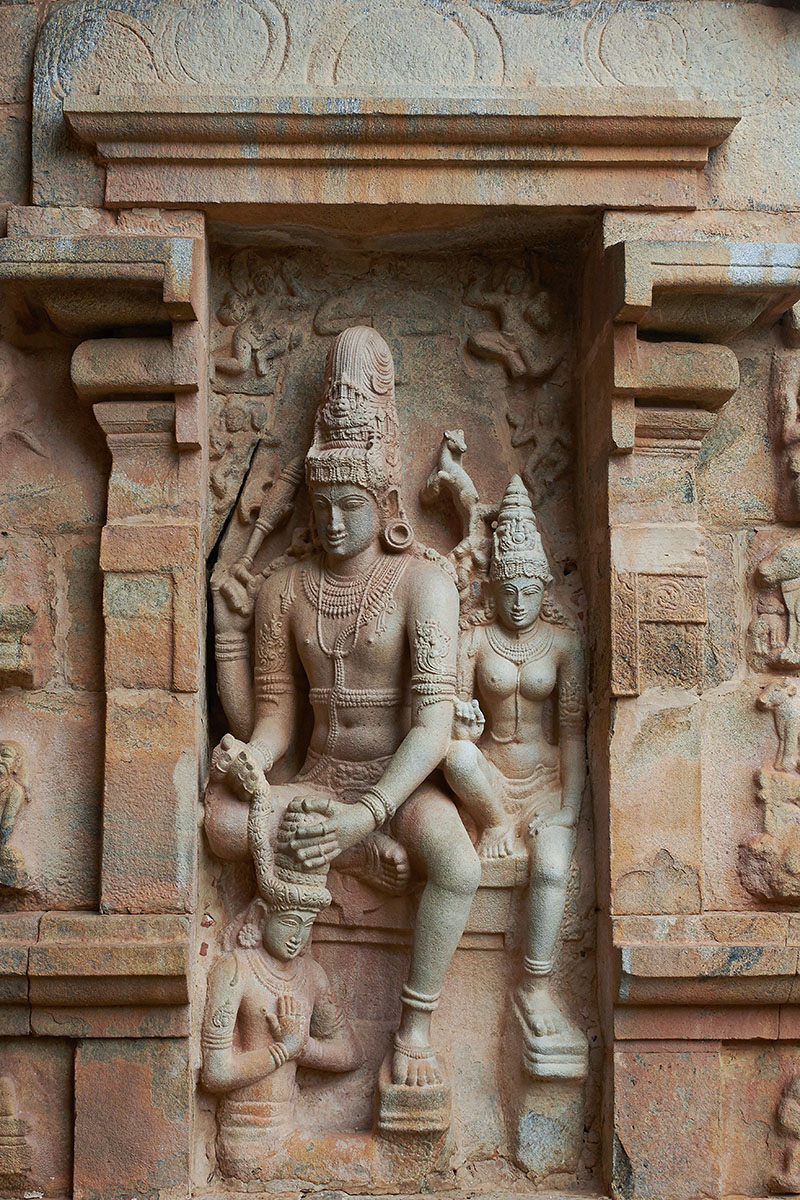Completed around 1030 CE by the Chola ruler Rajendra I, the Brihadishvara temple at Gangaikondacholapuram, Tamil Nadu incorporates highly intricate works of stone sculpture that are linked to the presentation of the Cholas as victorious Shaivite kings.
There are around fifty sculptures on the walls of the garbhagriha, while others are found on the walls of the mahamandapa, ardhamandapa, and various secondary shrines in the complex. Dvarapala figures are present at the gateways between the mandapas and the garbhagriha. The vimana also features a number of colossal sculptures, and the temple was endowed with bronze idols including Somaskanda, Skanda, Durga and Bhogashakti.
The garbhagriha features two tiers containing large sculptural niches. In both tiers, Dakshinamurti is positioned in the south and Brahma in the north. In the west, Vishnu is in the lower tier while the Lingodbhavamurti form of Shiva is in the upper. The lower tier of the east wall features images of Chandesanugrahamurti on the north and Kankalamurti on the south, positioned such that they are clearly visible to visitors entering the ardhamandapa. In the tier above them are sculptures of Gajasasurasmhara and Chandra (above Chandesanugrahamurti), and Surya and Agni in the south above Kankaladhara. On the west wall of the mahamandapa facing Chandesanugrahamurti and Kankaladhara are images of Sarasvati and Lakshmi respectively.
Most of the sculptures depict Shiva’s superiority over other deities, presenting narratives from the Agamic texts. However, some images suggest an improvisation of extant Shaivite traditions to support a narrative of Rajendra I as a militarily successful monarch legitimised by his devotion to Shiva. For instance, the Chandesanugrahamurti depicts Shiva, accompanied by his consort Parvati, bestowing the Nayanar saint Chandesa with a floral garland. This may be interpreted as a portrayal of Rajendra being rewarded for his victorious campaigns by Shiva himself. The temple also exhibits a greater profusion of Vaishnavite imagery than those of Rajendra I’s father Rajaraja Chola I: a sculpture of the Bhuvaraha form of Vishnu is positioned on the upper tier of the north face of the garbhagriha exterior, and Vishnu himself is presented on the west face. It is possible that these depictions, particularly Bhuvaraha, are meant to be a reference to the Later Western Chalukyas, a Deccan polity situated to the northwest of the Cholas who used the deity as their emblem.
Other Deccan and Kalinga sculptures, appropriated through war, further attest to the temple’s identification with Chola power and military successes. A solar altar in the northwest of the mahamandapa has been identified as originally of Deccan workmanship. Two idols of Bhairava and one of Bhairavi have been found; similar to sculptures found in Bhubaneshwar and Konark in present-day Odisha; all the three sculptures are carved in red sandstone and have thus been understood as specimens of Kalinga art that generals of Rajendra I might have brought back with them during their raids in the 1020s CE.
The temple was declared a UNESCO World Heritage Site in 1987 as one of the Great Living Chola Temples, and continues to be a major site of worship and tourism today.







